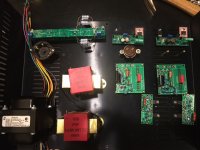Actually I have done many of this on my phono stage. There is already tesla az1 mesh rectifier with tesla old transformer. And its sounds really good. First and second capacitor best to be foil oil, or at least oil filled its true. But last one i still preffer good electrolytic, not because of the size or filtering, but because it has more balanced sound in my system. Allfilm sound shouty and annoying. Telfon caps are defenitly not to my taste too.
But the question is is there any difference between relatively cheap transformer and super expansive japanese. Should we avoid toroid or maybe preffer c-core more than ei? I ask because next my move is to buy one for my preamp, i wanna be sure.
But the question is is there any difference between relatively cheap transformer and super expansive japanese. Should we avoid toroid or maybe preffer c-core more than ei? I ask because next my move is to buy one for my preamp, i wanna be sure.
The expensive Japanese transformers may be very good for amplifier power supplies, where the music signal (current) flows in the DC supply capacitor. Class-AB transistor power amp is an example.
But with filament supplies using my regulator, the signal is very highly-isolated from the Raw DC supply. So there is effectively zero signal-current in the DC supply.
With filament supplies, the important consideration is that the DC supply is floating. This means that anything you can do to block noise from coming through the transformer will help prevent common-mode noise reaching the amplifier.
EI transformers are good, and the leakage capacitance may be as low as 40pF. Screened transformers are potentially better still.
Some of the Audio-grade transformers are designed to run with lower magnetic field, and more safety-margin for the maximum input voltage. This is a good idea for preamps, and helps keep magnetic field away from signal wiring and components.
- Or you can mount the transformer in a separate chassis, and screen the cables between power and signal boxes.
But with filament supplies using my regulator, the signal is very highly-isolated from the Raw DC supply. So there is effectively zero signal-current in the DC supply.
With filament supplies, the important consideration is that the DC supply is floating. This means that anything you can do to block noise from coming through the transformer will help prevent common-mode noise reaching the amplifier.
EI transformers are good, and the leakage capacitance may be as low as 40pF. Screened transformers are potentially better still.
Some of the Audio-grade transformers are designed to run with lower magnetic field, and more safety-margin for the maximum input voltage. This is a good idea for preamps, and helps keep magnetic field away from signal wiring and components.
- Or you can mount the transformer in a separate chassis, and screen the cables between power and signal boxes.
For Anode/Plate supply for preamp -
It depends on the circuit.
If you use unregulated DC for the anode, and transformer output, the design will be sensitive to transformer quality.
If you use Ale's anode-load (gyrator, µ-follower) or if you use a DC shunt regulator (example: SSHV) - the transformer is less instrusive, and you can use the screened audio-toroidal here too, or EI.
It depends on the circuit.
If you use unregulated DC for the anode, and transformer output, the design will be sensitive to transformer quality.
If you use Ale's anode-load (gyrator, µ-follower) or if you use a DC shunt regulator (example: SSHV) - the transformer is less instrusive, and you can use the screened audio-toroidal here too, or EI.
ok, thank you. If I use Mills, its better to use 2-4 parallel 12w to be sure?
It's unnecessary.
The dissipation (due to the starving or not) 0.9-1.1W.
I use Mills 1R 12W resistor (the 5W one turns brown).
I think that is correct for cathode bias, however if filament bias is being used it is more like 13w dissipationIt's unnecessary.
The dissipation (due to the starving or not) 0.9-1.1W.
I use Mills 1R 12W resistor (the 5W one turns brown).
Rk what is the best possible resistor type to use here?
If "Rk" is the filament bias resistor, must to use at least 25W ones (with appropriate heatsink), for example non inductive Wishay-Dale NH type one.
Best sounding resistors I've yet found. They do several values. They're pretty big - the Russians didn't mind size usually....
10 Ohm 10W Precision Wire Wound Russian Resistors 18 pcs | eBay
10 Ohm 10W Precision Wire Wound Russian Resistors 18 pcs | eBay
Last edited:
Please comment on my layout. See image. I am going for a single chassis build. Let's see if I get hum and noise. Might put a divider to make it basically two chassis.
PS is to the left. Main circuit to the right. DC heaters at the top, Ale's source follower at the bottom right.
DC heating toroid is on its way. Planned to go between the main trafo and the rectifier tube.
PS is to the left. Main circuit to the right. DC heaters at the top, Ale's source follower at the bottom right.
DC heating toroid is on its way. Planned to go between the main trafo and the rectifier tube.
Attachments
Are you going to use filament bias, which many of us find the best? If so you might seriously think of using an outboard filament supply, where you can use chokes if you want to optimise everything. And at least EI transformers and not a toroid. Simple to use a 4 pole XLR as a connector. That will keep a lot of possible noise problems out of the chassis.
- Home
- Amplifiers
- Tubes / Valves
- #26 pre amp

